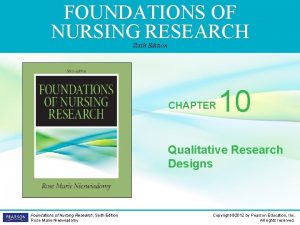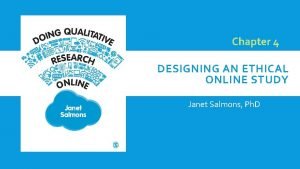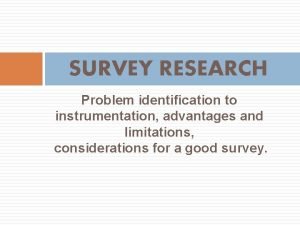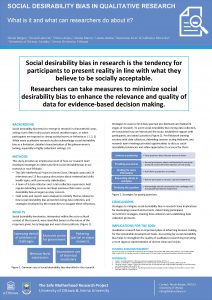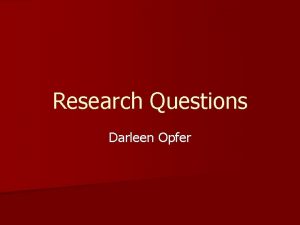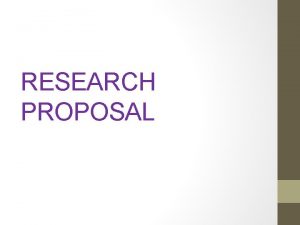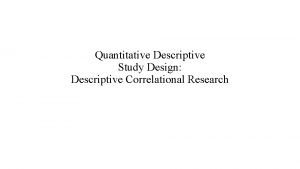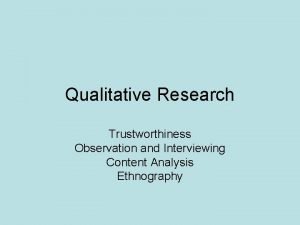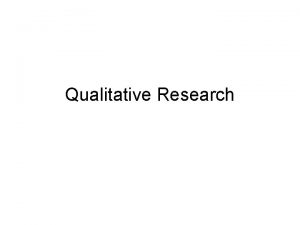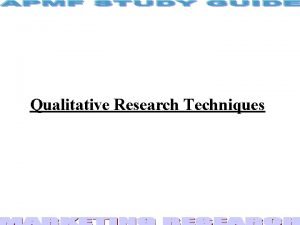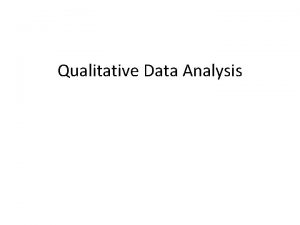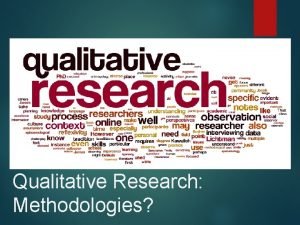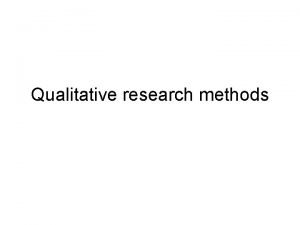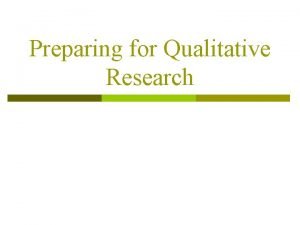Chapter 4 Introduction to Qualitative Research l l





















- Slides: 21

Chapter 4 Introduction to Qualitative Research l l l 1 Effective in capturing complexity of communication phenomena Sensitive to social construction of meaning Emphasizes communication environment of interactants Introduction to Communication Research, BU-CA

What is Qualitative Research? l l l 2 Preserves the form and content of interaction Contextually bound Discourse is the data Analyzed for its qualities – empirical, inductive, and interpretive Aims for subjectivity Allows interactants’ voices to be heard Introduction to Communication Research, BU-CA

Mutual Simultaneous Shaping l l 3 The here and now Everything influences everything else Emphasis on process and the holistic frame of interaction Plausible explanations built on what is observed Introduction to Communication Research, BU-CA

Analytic Induction l l l 4 From the specific to the general Explanations and theories emerge from the data Propositions formulated continuously throughout the data collection and data analysis process Introduction to Communication Research, BU-CA

Model for Qualitative Research l l 5 Interdependent stages Revise the design after considering impact of each component Top triangle reflects design of the project Bottom triangle reflects activities in the field Introduction to Communication Research, BU-CA

Conceptualizing Research Questions for Qualitative Research l l l 6 Based on previous literature Broadly stated Nondirectional Gives researcher latitude in following interesting paths Specific to the interaction context Introduction to Communication Research, BU-CA

Assessing Research Questions 7 l Does the question ask how or what? l Is the question nondirectional? l Does it reference the research site? Introduction to Communication Research, BU-CA

Assessing Research Questions l Does the question: – – – 8 Focus on a specific type of interaction? Discover how meaning is developed/shared? Reveal naturally occurring communication not suitable for study in an experiment? Reveal unanticipated phenomena/influences? Reveal process that occur over time? Explore the influences of the context? Introduction to Communication Research, BU-CA

What Counts as Data in Qualitative Research? l l Anything that can be observed or captured Interpreting meaning – – – l Level of evidence – 9 Researcher construction Subjective valuing Contingent accuracy Microlevel, midlevel, macrolevel Introduction to Communication Research, BU-CA

Making the Case for Qualitative Research l Advantages – – – l Limitations – – 10 Documents the unseen Provides information about those who cannot or will not speak for themselves Supplements information from quantitative studies Communication environment must be accessible Interactants may change their behavior Observations filtered through the researcher Time consuming Introduction to Communication Research, BU-CA

Issues of Reliability and Validity l l l 11 Focus on the reliability and validity of the techniques or processes used to collect and analyze data Validity achieved when report accurately reflects communication observed Validity best assessed by those observed Introduction to Communication Research, BU-CA

Threats to Reliability and Validity in Qualitative Research l l l 12 Inaccuracy or incompleteness of data Problems of interpretation – yours/theirs? Similarity/difference in treatment of data Data that does not fit cannot be dismissed Selection bias Reactivity bias Introduction to Communication Research, BU-CA

Comparing Quantitative and Qualitative Research l l l 13 One methodology is not inherently better than the other Each has advantages and limitations Method should be selected because it helps the researcher answer hypotheses and research questions Introduction to Communication Research, BU-CA

Key Differences 1. 2. 3. 4. 14 Quantitative Uses numbers Participants randomly selected Removes some level of contextuality Relies on formal logic 1. 2. 3. 4. Qualitative Uses detailed descriptions Participants selected purposely Deeply contextualized Interpretive frame Introduction to Communication Research, BU-CA

Key Similarities l Both quantitative and qualitative methods – – – 15 Rely on empirical evidence Provide useful information for describing, understanding, and explaining human communication behavior Needed to develop complete picture of communication Introduction to Communication Research, BU-CA

Which Method Do You Choose? l Choose the method that answers, What do I want to know? – – 16 Which method will increase the validity, reliability, and generalizability of the data? Which method will maximize the amount of useful data generated to answer the question posed? Introduction to Communication Research, BU-CA

Triangulation l Use of several methods or data to validate outcomes – – – 17 Data triangulation Investigator triangulation Theory triangulation Methodological triangulation Interdisciplinary triangulation Introduction to Communication Research, BU-CA

Triangulation l l l 18 The use of both quantitative and qualitative data in same study. Mixed method research. Welcoming a wide variety of methodological approaches. Introduction to Communication Research, BU-CA

Triangulation l l 19 Triangulation is the application and combination of several research methodologies in the study of the same phenomenon. Triangulation was originally used in social sciences and has now spread to psychology. It can be employed in both quantitative(validation) and qualitative(inquiry) studies. It is a method-appropriate strategy of founding the credibility of qualitative analyses. It becomes an alternative to " traditional criteria like reliability and validity " It is the preferred line in the social sciences Introduction to Communication Research, BU-CA

Why use triangulation l 20 By combining multiple observers, theories, methods, and empirical materials, sociologists can hope to overcome the weakness or intrinsic biases and the problems that come from single method, singleobserver, single-theory studies. Often the purpose of triangulation in specific contexts is to obtain confirmation of findings through convergence of different perspectives. The point at which the perspectives concerge is seen to represent reality. Introduction to Communication Research, BU-CA

Types of Triangulation: l l 21 data triangulation, involving time, space, and persons theory triangulation, which consists of using more than one theoretical scheme in the interpretation of the phenomenon. methodological triangulation, which involves using more than one method and may consist of withinmethod or between-method strategies. multiple triangulation, when the researcher combines in one investigation multiple observers, theoretical perspectives, sources of data, and methodologies. Introduction to Communication Research, BU-CA
 Research appendices example
Research appendices example Chapter 3: research methodology
Chapter 3: research methodology Quantitative qualitative
Quantitative qualitative Purpose of qualitative research
Purpose of qualitative research Findings of qualitative research
Findings of qualitative research Qualitative research designs chapter 10
Qualitative research designs chapter 10 Chapter 5 qualitative research example
Chapter 5 qualitative research example Ethical issues in qualitative research chapter 4
Ethical issues in qualitative research chapter 4 5 characteristics of qualitative research
5 characteristics of qualitative research Qualitative research is viewed in a holistic perspective.
Qualitative research is viewed in a holistic perspective. Type of data collected in quantitative research
Type of data collected in quantitative research What is methodological integrity
What is methodological integrity What is the sample size in qualitative research?
What is the sample size in qualitative research? Social desirability bias in qualitative research
Social desirability bias in qualitative research Qualitative research traditions
Qualitative research traditions Random sampling method in quantitative research
Random sampling method in quantitative research Purposive sampling
Purposive sampling Qualitative research results and discussion
Qualitative research results and discussion Research question examples
Research question examples Expected result in research proposal example
Expected result in research proposal example Research design
Research design Observation sheet in qualitative research
Observation sheet in qualitative research





